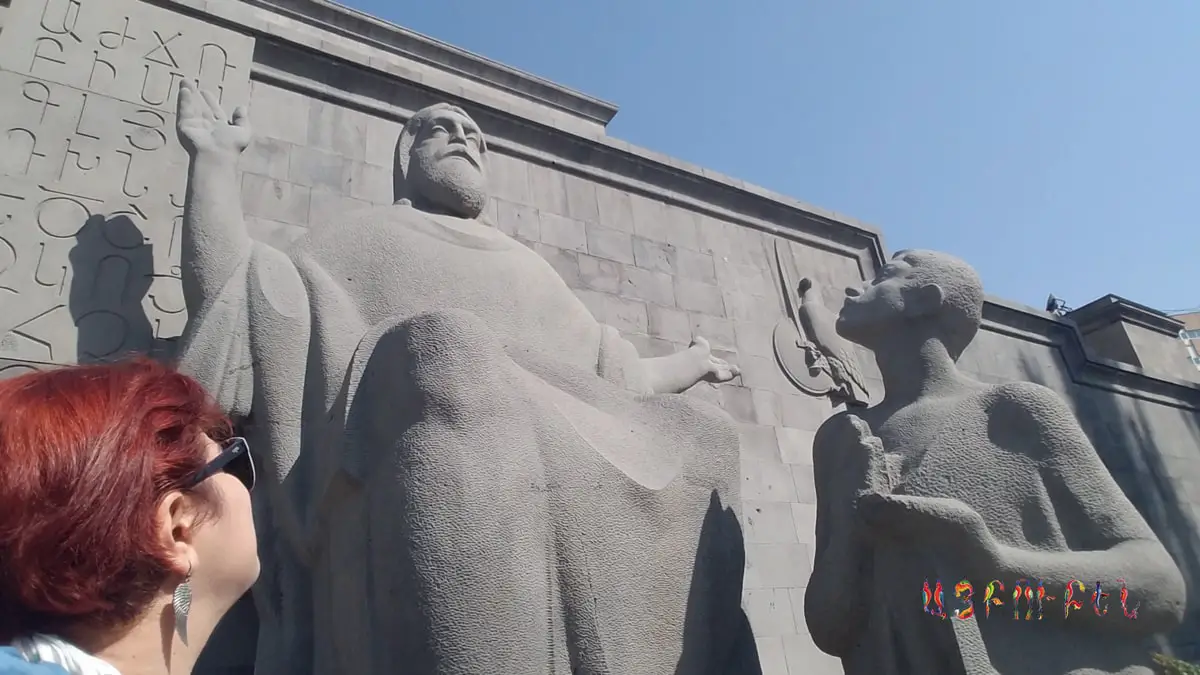Day of Holy Translators
The Armenian Church celebrates the memory of the Holy translators on the second Saturday of October. The Holy Translators were Mesrob Mashdots, Yeghishe, Movses, David the invincible, Krikor Naregatsi, and Nerses Glayetsi.
The thought of this day takes me back to last week I went to the “Madenataran” in Yerevan. The huge stone National Library building contains 23000 manuscripts, fragments and Amulet Scrolls, in addition to 500.000 archived documents. It is located on 53 Mashtots Avenue, Yerevan 0009. The main building of Matenadaran (1957) was designed by Architect Mark Grigoryan. The new building of the research institute (2011) was designed by Architect Arthur Meschyan.
My Trip to Madenataran
Mesrob Mashdots sits at the entrance proudly showing his student Gorune, the first translated sentence inscribed behind him on the wall. “Janachel zimasdoutiun yev zkhrad imanal zpanen Hanjaro” , that translates to “To know wisdom and instruction to perceive words and understanding”. I learn that although the Armenian Alphabet dates back to 405 AD, the Holy translators finished translating the first bible in 425 AD.
As I am headed towards the entrance I see my first ancient “Khatchkar” Cross-stone, from the 12th Century. I walk up the stairs and enter the great gates guarded by Toros Roslin, Krikor Datevatsi, Anania Shiragatsi, Movses Khorenatsi, Mkhitar Kotch and Frig. The first floor is where I see the handmade souvenirs and silk hand-painted scarves facing the reception desk, where I ask for permission to photograph the ancient treasures.
The manuscripts are shown on the 4th floor. I enter the Exhibition Hall and start taking photographs, unable to stop my tears. I stop in front of the Msho Charentir (Homilies of Mush), remembering the stories of how the book was saved by two mothers escaping the Ottoman atrocities, who decide to divide the book into two to hold it with one hand and their children in the other. I fall on my knees crying then I gather my strength to continue my journey on the Armenian Cultural lane between the 405 Ad and the 18th Century.
What can you see at the Madenataran

Armenian Literature, arts, old Armenian translations, Manuscript decorations, medieval science books as well as art (history, philosophy, exact sciences, cosmology, medicine, literature, etc.).
Medieval Armenian miniature paintings and specimens of medieval bindings. Survived manuscripts from the Genocide, works of the Artsakh School, with artistic specificity and distinguishable features. Miniature paintings from the Schools of Bardzr Haik (Upper Armenia), Cilician Armenia, the Crimea, and Constantinople.
Survived Manuscripts from Van and Vaspourakan, Mush, Karin, and Zeytun. Miniature manuscripts of Cilician School (School of Toros Roslin). Digital copies of numerous manuscripts shown by the electronic monitors on the wall. Dashunahar Gospel, Hrashagorts Gospel, “The Book of Lamentations” of St. Gregory of Narek, one of the Holy Translators.
Maps reprinted from Medieval Armenian, Latin, Greek, Arabic and other manuscripts that depict the ancient world and medieval geographical knowledge. The first map printed in Armenian is also shown (Amsterdam, 1695).
Medieval Beauty products that are sold at the Madenataran
In the Medieval Medicine exhibition hall, there are medical books that have not only historical and theoretical but also modern and practical significance.
In the Medieval Armenian Medicine laboratory of the Matenadaran, specialists use “cochineal” worms and aromatic plants and roots, that grow only in the Armenian Highland, to prepare wholesome “Royal Balm,” floral teas, and rejuvenating, anti-aging skin oils used by “noble women” in the Middle Ages.
These items are unique souvenirs that are sold only in the Matenadaran; they are prepared according to medieval recipes. There are also displayed ingredients used to make natural dyes and the Holy Myrrh.

